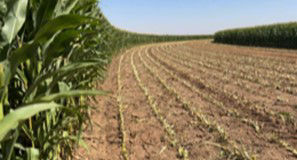Selecting Corn Products for Silage
October 25, 2023
It is important to select the correct corn product for silage (Figure 1). Producers that are unsure of which market for selling; grain or silage, may be able to pick a dual-purpose product. Generally high yielding grain products translate well to silage, though fiber digestibility should be examined. Product selection should go beyond the end purpose with local agronomics being a large factor. Tolerance to local insects, diseases, or weather patterns can help increase general plant health and potential yields.1 The end user of the silage should also be considered. Milk and beef producers may be looking for different qualities, so understanding their needs would give further guidance for product selection.

Selecting the Correct Maturity
Corn products with longer relative maturities (RM) tend to have higher yield potential because they have more opportunity to accumulate dry matter. A product with too long of a maturity for grain for the area can still be considered since corn silage is harvested before physiological maturity. Corn silage is typically harvested between 65 and 70 percent moisture content because that is when yield and quality is highest, though there can be some variation based upon the storage method (Figure 2).2 Relative maturity of a product may be increased 5 to 10 days.2 Consideration of the length of the growing season is to avoid frost and or freeze prior to maturity (Figure 3). Other factors should be considered such as average weather patterns during the harvest period. If wet weather or high winds are common late in the season, it may be beneficial to shorten the RM of the product.1


Populations
Corn silage can be planted at a higher seeding rate than corn planted for grain. Higher populations may increase the yield potential. Though yields may increase, higher populations may also decrease the plant and ear size which can decrease silage quality. Research has indicated a silage seeding rate of 1,500 seeds per acre more than grain corn can help maximize milk production.3
Conclusion
There are many factors to consider when selecting a corn product for silage. Understanding who will be using the final product can offer insights in the best products and management practices. Consulting with your seed representative is a great first step to review data from field testing.
Mark Bartel
Channel Agronomist
Sources
1Hybrid Selection. Silage. Corn Agronomy. University of Wisconsin-Madison. http://corn.agronomy.wisc.edu/Silage/S001.aspx
2Sulc, M., Thomison, P., and Weiss, B. 2020. Corn silage harvest timing. C.O.R.N Newsletter 2020-28. The Ohio State University. https://agcrops.osu.edu/newsletter/corn-newsletter/2020-28/corn-silage-harvest-timing
3Coulter, J. 2021. Strategies to optimize corn silage production. University of Minnesota Extension. https://extension.umn.edu/corn-planting/strategies-optimize-corn-silage-production
Web sites verified 9/8/23. 1110_292101
You may also like...
Here are some articles that may also be of interest to you